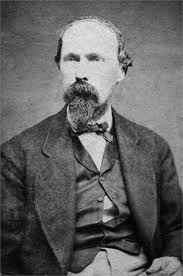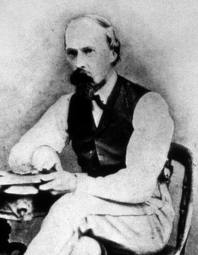 Lincoln Conspirator, Samuel A. Mudd, was not only a respected and wealthy Rural Country Doctor, but a slave owner, tobacco farmer and Confederate sympathizer. Whether Doctor Mudd was involved in the plot to kidnap Lincoln or in the assassination conspiracy remains a mystery to this day. What is not in doubt is the fact that he ministered to John Wilkes Booth’s broken leg and nursed the assassin for at least 12 hours after the murder of President Lincoln. Legal scholars and historians continue to debate the constitutionality of the military tribunal that determined the guilt and fate of the accused conspirators, however the verdicts of the defendants were almost certainly pre-ordained by President Andrew Johnson and Secretary of War Edwin Stanton.
Lincoln Conspirator, Samuel A. Mudd, was not only a respected and wealthy Rural Country Doctor, but a slave owner, tobacco farmer and Confederate sympathizer. Whether Doctor Mudd was involved in the plot to kidnap Lincoln or in the assassination conspiracy remains a mystery to this day. What is not in doubt is the fact that he ministered to John Wilkes Booth’s broken leg and nursed the assassin for at least 12 hours after the murder of President Lincoln. Legal scholars and historians continue to debate the constitutionality of the military tribunal that determined the guilt and fate of the accused conspirators, however the verdicts of the defendants were almost certainly pre-ordained by President Andrew Johnson and Secretary of War Edwin Stanton.
Samuel Alexander Mudd was born on December 20, 1833, on a large tobacco plantation in Charles County, Maryland, about 30 miles southeast of Washington D.C. and the farm was worked by at least 89 slaves. Mudd was the fourth of ten children and when he was young he was educated at home, by his father and a nanny. At age 14 he entered St. John’s College in Frederick, Maryland. After two years he enrolled at Georgetown College in Washington, D.C. In 1854 he attended the University of Maryland in Baltimore and studied medicine and surgery, graduating in 1856.
After Medical School, Mudd returned home and began his career as a rural country doctor and tobacco farmer. In 1857, he married Sarah Dyer and their first child was born in November of 1858. By 1859 the couple owned a farm of their own and five slaves, about 30 miles south of Washington, D.C. The young couple had three additional offspring, one in 1860, another in 1862 and a third in 1864. Doctor Mudd felt that slavery was a God-given right and at the beginning of the Civil War he was an ardent Confederate supporter and his farm was a way station for Southern couriers.
In 1864, Maryland, abolished slavery, making it difficult for farmers to operate their plantations. Mudd considered selling his farm and he was introduced to someone who said he might be interested in buying his property, John Wilkes Booth. On Sunday, November 13, 1864, John Wilkes Booth first met Dr. Mudd at St. Mary’s Church near Bryantown, Maryland. Another meeting of the two men took place on December 18 at the Bryantown Tavern. On December 23, the two men met yet again in front of Booth’s hotel in Washington, D.C. Booth wanted Mudd to introduce him to another Southern sympathizer, John Surratt. As Booth and Mudd were chatting, Louis Weichmann and John Surratt approached and all four men gathered for drinks in Booth’s hotel room. It is believed that Lincoln’s kidnapping was discussed and planned at this meeting.
After President Lincoln’s foiled kidnapping, inauguration assassination attempt and Lee’s surrender at Appomattox, Booth’s plot to murder Lincoln and members of his cabinet swung into high gear. The actor had already recruited his murderous cabal, assigned targets to individual conspirators, identified the location and means of killing Lincoln and planned his escape and supply route out of Washington D.C. Booth was informed that Ulysses S. Grant would be attending Ford’s Theater on April 14, 1865, with President Lincoln and he figured he would shoot Lincoln and stab Grant, making a speedy escape south to Richmond.
Several strange coincidences surround Lincoln’s assassination. Ward Hill Lamon, President Lincoln’s guardian angel and body-guard was out-of-town, on a special mission, the agent assigned to guard Lincoln’s box, was next door having a shot of whiskey and Grant failed to attend the performance. A peep-hole had been drilled in the wall of the box seating and a wooden bar had been installed to block anyone from trying to enter the Presidential enclosure after Booth entered. All avenues of escape out of Washington were blocked, on Secretary Stanton’s instructions, except the road that Booth traveled out of the city.
When Booth shot Lincoln he broke his left leg in his leap from the box to the stage. Around 4 in the morning, on April 15, Booth and David Herold arrived at Mudd’s farm. Doctor Mudd set and bandaged the broken leg. Mudd later told investigators that he did not recognize his patient. He said the two used the names “Tyson” and “Henston.” Mudd related that he left the farm to do some errands for his wife and while in Bryantown he heard of the assassination. Booth and Herold stayed with Mudd for 12 hours and the Doctor supplied the crippled assassin a pair of home-made crutches. Booth paid Mudd $25 for his services and they soon rode off in the direction of Parson Wilmer’s residence.
Mudd did not immediately contact the authorities. When military investigator, Lieutenant Alexander Lovett, reached Mudd’s home on April 18, the Doctor claimed that he did not recognize the man whose leg he fixed. Three days later, Lovett conducted a search of the Mudd home and discovered a riding boot with the name J. Wilkes written on the inner lining. When Lovett showed Mudd the writing in the boot, Mudd told Lovett that he had not noticed the writing. Shown a photo of Booth, Mudd still claimed not to recognize him. Doctor Samuel Mudd’s obvious lies would eventually lead to his arrest and after Booth’s death he would be charged with conspiracy to murder President Abraham Lincoln and harboring Booth and Herold during their escape.
On May 1, 1865, President Johnson ordered the formation of a nine-man Military Commission to try the conspirators. It was argued by Secretary of War Stanton, that the men should be tried by a military court. Several members of the cabinet, disapproved, preferring a civil trial. However,the Attorney General, James Speed, agreed with Stanton and there was no jury trial.
Mudd was one of eight people arrested and charged as accomplices to Abraham Lincoln’s
murder. Mudd was represented by General Thomas Ewing. The trial began on May 10, 1865 and the Doctor admitted that he had met Booth once before the assassination, but maintained that Booth wore a disguise when he came to his home. The prosecution called over 366 witnesses and literally buried any credibility that Mudd or his counsel, could present.
All of the eight defendants were found guilty, barely two months after President Lincoln’s murder. Four were hanged, and the other four, including Mudd, were given prison terms at Fort Jefferson, a military prison in the Dry Tortugas, off the coast of Florida. Stanton, Speed and Johnson had engineered a stealthy and politically efficient end to one of darkest deeds in American history. Utilizing the dynamics of media and public opinion, the political power of military justice, circumventing the constitutionality to the right of habeas corpus, Secretary of War Stanton and his minions assured that much of the intrigue of Lincoln’s assassination would be lost to the ages.
 Doctor Samuel Mudd was sentenced to life in prison, but spent less than four years incarcerated. Two years after his arrival the island’s only doctor died in an outbreak of yellow fever and Mudd volunteered to act as doctor for the prison. Mudd provided medical aid for hundreds of inmates, guards, and soldiers as the epidemic progressed, even after he himself contracted the disease. When the epidemic ended, most of the survivors signed a petition asking President Johnson to forgive Mudd’s crime. In addition, his defense attorney, Thomas Ewing, who was influential in the Johnson administration, lobbied for his release. On February 8,1869 the President granted him an unconditional pardon and immediate release. Mudd then returned to Maryland, where he resumed his career as a physician and farmer. Samuel Mudd stayed abreast of politics and ran for a Maryland House of Delegate seat in 1877, but lost to a popular Republican, he fathered another child in 1878 and died of pneumonia at age 49, in 1883.
Doctor Samuel Mudd was sentenced to life in prison, but spent less than four years incarcerated. Two years after his arrival the island’s only doctor died in an outbreak of yellow fever and Mudd volunteered to act as doctor for the prison. Mudd provided medical aid for hundreds of inmates, guards, and soldiers as the epidemic progressed, even after he himself contracted the disease. When the epidemic ended, most of the survivors signed a petition asking President Johnson to forgive Mudd’s crime. In addition, his defense attorney, Thomas Ewing, who was influential in the Johnson administration, lobbied for his release. On February 8,1869 the President granted him an unconditional pardon and immediate release. Mudd then returned to Maryland, where he resumed his career as a physician and farmer. Samuel Mudd stayed abreast of politics and ran for a Maryland House of Delegate seat in 1877, but lost to a popular Republican, he fathered another child in 1878 and died of pneumonia at age 49, in 1883.
Shortly after Doctor Samuel Mudd’s death, his descendants began petitioning United States officials, to change the official record in regard to Mudd’s conviction, citing constitutional violations and court proceedings. Most recently Presidents Carter and Reagan, stated that they believed in Mudd’s innocence, but had no authority to overturn a military conviction. Many legal pursuits were explored, ending in 2003 when the United States Supreme Court stated that the deadline for the filing had been missed.
Doctor Mudd was a Lincoln Conspirator, maybe not in the planning of the assassination of President Lincoln, but he was surely more than just an innocent Rural Country Doctor.
Bummer


Interesting – until reading this I’ve thought of him as almost as shocking a victim of the blind vengeance over Lincoln assassination as Mary Surratt. I’ll have to alter my opinion now. Thanks.
Louis,
None of those arrested and charged were entirely innocent. The shocking rush to judgement and total diregard of constitutional guarantees is appalling. All were guilty of treason and abetting, but the varying degrees of guilt and punishment and their lack of a competent legal defense still is an embarassment to our democratic process. It will be interesting to see how the Boston Bomber is tried, as an enemy combatant or as a civilian criminal.
Bummer
04/20/13 Bummer-
After their convictions in Military Court, Dr. Samuel A.Mudd was imprisoned at Fort Jefferson along with three others (Samuel Arnold; Edmund Spangler; and Michael O’Laughlen). O’Laughlen died in the ‘yellow fever’ outbreak at Fort Jefferson in Sept 1867 while under Dr. Mudd’s care. Arnold and Spangler were also pardoned by Pres. Johnson around the same time as Mudd (Early 1869). In 1867, John Surratt was acquitted in a civil court trial by a jury when his defense counsel established that he was in Elmira, N.Y. on April 14, 1865 and not in Washington, D. C. as the prosecution claimed.
John,
Thanks for the additional details regarding the other conspirators. The whole military commisssion was rigged by Johnson, Stanton and Speed. Not that the conspirators were not guilty, but the power elite wanted to wash their hands of the whole mess and keep the media and public opinion under a tight reign. A military court didn’t have to play the constitutional game. Thanks for your input.
Bummer